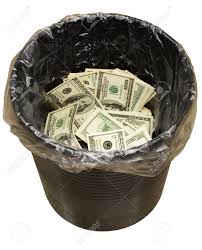
Every Bag is Thrown Away
Everybody uses trash bags. We use them in kitchens, bathrooms, offices, common areas, industrial areas, and of course outside as well. Also known as trash liners, they exist to capture, store, and remove waste. It really is that easy. Every trash bag costs money, and they all get thrown away. You can save money… lots of money (more on that later) by choosing the right bag for the job.
What is the Right Bag?
When choosing the correct trash bag, consider the following:
- Capacity
- Resin
- Max Load
- Seal
- Color
- Facility Specific Factors
The Capacity of a bag refers to the volume of trash that will fit inside the bag. Since most bags are used inside of trash cans and other waste receptacles, it is important to know the size of shape of the trash can to choose the correct trash bag. A general 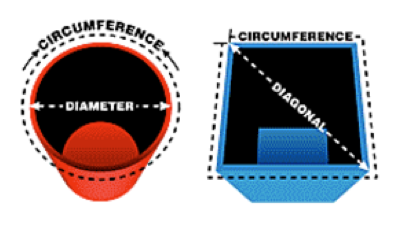 guideline for choosing the correct size bag is to make sure the width of the bag is equal to ½ of the circumference of the trash can and the length is equal to the height of the trash can plus 4” to allow for enough bag to overhang the trash can without falling inside.
guideline for choosing the correct size bag is to make sure the width of the bag is equal to ½ of the circumference of the trash can and the length is equal to the height of the trash can plus 4” to allow for enough bag to overhang the trash can without falling inside.
There are two primary types of plastic Resins used to manufacture trash bags. High Density trash liners are fantastic for general office conditions because they can hold heavy loads if that trash does not have rough or sharp edges. Low Density liners, on the other hand, can better hold materials that may puncture or tear the bag. High Density liner thickness is measured in microns, and Low Density liner thickness is measured in mils. Plastic resins have advanced over the years and the best trash liners can use just 1/3 of the plastic resin compared to previous generations of liner technology.
The Max Load of a bag is defined as the maximum amount of weight that the liner can hold under ideal conditions. Many years ago, it was common knowledge that “thicker was better.” This is no longer the case. As a facility expert, you’ve probably heard or described the bag you need by talking in terms of its thickness. For example, a cleaning contractor might determine that they will use a 16-micron high density trash liner in a trash can. But what if the conversation was not about the thickness, but instead about the load? Using a trash liner best suited for the material load can often produce considerable savings because in many cases the current solution is overkill and a thinner bag will accomplish the job of capturing, storing, and removing waste.
Trash liners are manufactured using 3 types of Seals. Star Seals, Flat Seals, and Gusset Seals hold the plastic together. Most commercial trash liners are produced using a Star Seal that conforms well to the trash can, distributes the weight of the load evenly, and reduces the potential for leaking.

Sometimes the Color of a trash liner is important. For example, many hospitality teams will train staff to use black bags so that when the bag is carried through common areas, the contents aren’t visible to patrons and guests. Other times the color of a bag is part of a specific safety initiative such as red, blue, and yellow bags printed for infectious contents.
Other Facility Specific Factors that may influence your decision when purchasing liners are the location of the trash receptacle itself, an environmentally friendly initiative, interest in drawstring closure, flexible resins, and even bags impregnated with antimicrobial agents and odor counteractants.
Low Hanging Fruit
Through our SmartSite™ Analysis program 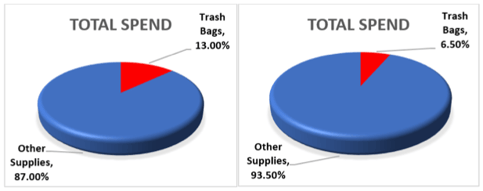 we have identified that 9-13% of facility cleaning and sanitary maintenance supply purchase expenses are trash bags. When you purchase trash bags, the hidden secret is that there is no secret. Plastic resin costs money and you are paying for the plastic when you purchase trash bags. By considering Capacity, Resin, Max Load, Seal, Color, and any Facility Specific Factors when evaluating you trash bag program it is possible to save upwards of 50% on the entire category. Comment and tell us your trash bag expenses and the savings you could expect by optimizing your program with these helpful tips!
we have identified that 9-13% of facility cleaning and sanitary maintenance supply purchase expenses are trash bags. When you purchase trash bags, the hidden secret is that there is no secret. Plastic resin costs money and you are paying for the plastic when you purchase trash bags. By considering Capacity, Resin, Max Load, Seal, Color, and any Facility Specific Factors when evaluating you trash bag program it is possible to save upwards of 50% on the entire category. Comment and tell us your trash bag expenses and the savings you could expect by optimizing your program with these helpful tips!
Click the trash bag $avings graph below and an Action Representative will contact you to discuss your Savings Opportunity!
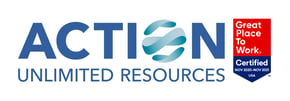

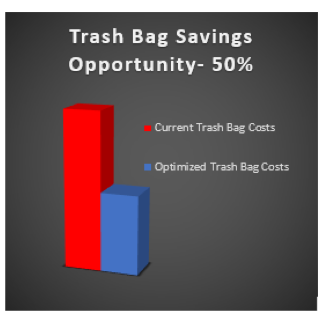

Enjoy this blog? Leave a comment or ask a question!